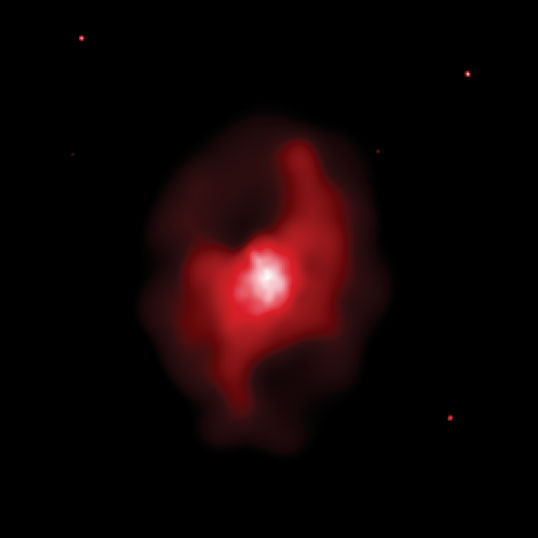


Credit: NASA/CXC/Ohio U./B.McNamara
This Chandra image shows two vast cavities - each 650,000 light years in diameter - in the hot, X-ray emitting gas that pervades the galaxy cluster MS 0735.6+7421 (MS 0735 for short).
Heating a Distant Galaxy Cluster by Giant X-ray Cavities and Large-Scale Shock Fronts
B. R. McNamara (Ohio U.), P. E. J. Nulsen (CfA)
M. W. Wise (MIT/CSR) D. A. Rafferty (Ohio U.)
C. Carilli (NRAO), C.L. Sarazin (U. Virginia),
E. L. Blanton (Boston U.)
Nature, January 6, 2005
Abstract:
We report the discovery of a pair of giant cavities, each nearly 200 kpc in diameter, embedded in the gaseous halo of the redshift z=0.216 galaxy cluster MS0735.6+7421. The cavities appear as surface brightness depressions in an image of the cluster taken with the Chandra X-ray Observatory. The X-ray cavities are filled with radio emission and are bounded by an elliptical shock structure resembling a “radio cocoon.” The shock's energy and age, ~6E61 erg and ~100 Myr, respectively, give a time averaged power of ~1.7E46 erg/s, making it the most powerful radio outburst known. The outburst is apparently heating the cluster by 1/3 keV per particle, which is sufficient to quench a large cooling flow for several Gyr and to supply a substantial fraction of the energy required to “preheat” the cluster. If the outburst was powered by accretion onto a supermassive black hole, more than 3E8 solar masses of material would be required to do so. This implies that the putative supermassive black hole lying at the center of the cD galaxy has accreted a substantial fraction of its own mass in less than 100 Myr.
See also:
Most
Powerful Eruption in the Universe Discovered
How Black
Holes Both Consume and Eject Material, Chandra, Harvard Center for Astrophysics
Chandra Observatory News
Discovery
Channel
RedNova